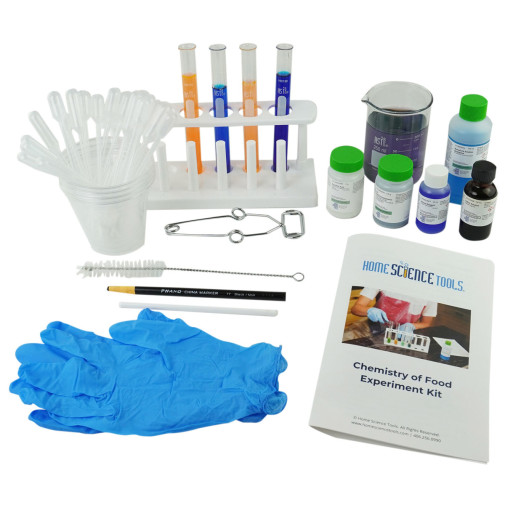We use cookies to make your experience better. To comply with the new e-Privacy directive, we need to ask for your consent to set the cookies. Learn more.
Chemistry of Food Experiment Kit
Curious about what food has the most Vitamin C to build the immune system? Maybe your teenager wants to lift weights and build muscle, what is the best protein food to eat? Learn the answers to this question and others with this hands-on experiment kit that offers guided and open-ended activities to test your favorite foods! Through the activities, students will learn how to form a hypothesis, make an aqueous solution, mix and measure, and record and chart data. Kit contains instructions for five nutrition-based experiments that test for glucose, starch, protein, lipids and Vitamin C, an introduction to science experiments, nutrition, preparing solutions, ideas for further study, and small-format, charts to record test results. Along with the Instruction Guide, the kit includes 6 glass test tubes, test tube rack, 250 ml glass beaker, test tube clamp, disposable pipets, and a wax pencil. It also includes the following chemicals: Biuret reagent (protein indicator), Benedict’s Solution (glucose indicator), Indophenol (Vit. C indicator), Lugol’s iodine solution (starch indicator), and ascorbic acid (Vit. C). A mortar and pestle are recommended, although the back of a fork and knife may be used to grind food for activities. The opportunities for discovery are limitless with this kit! Test store bought jelly vs. homemade, canned vs. frozen vegetables or fruit, or maple syrup compared to honey. You get the idea! This kit may compel students and parents alike to rethink their eating habits! ~Deanne
Looking for engaging, tasty science kits for kids? Look no further! Using this Chemistry of Food Experiment kit, students can conduct food chemistry experiments that are both interactive and educational. Kids can create their own home science labs and discover how to test for protein, glucose, starch, and vitamin c. This kit also includes a detailed step-by-step instruction manual to guide you through five hands-on experiments. This kit is a great launchpad for science fair project ideas!
Contents List: 6 Large Test Tubes; Test Tube Rack; Test Tube Holder; Biuret Reagent (protein indicator) Note: the biuret reagent has a shelf life of 12 months. Benedict's Solution (glucose indicator); Lugol's Iodine (starch indicator);Indophenol (vitamin C indicator); Ascorbic Acid (vitamin C);Pipets (droppers); 250 ml Glass Beaker; Wax Pencil (for marking on glass); Experiment Guide (with charts to record test results)
| Product Format: | Other |
|---|---|
| Brand: | Home Science Tools |
| Grades: | 6-12 |
| Length in Inches: | 4.4375 |
| Width in Inches: | 10.375 |
| Height in Inches: | 12 |
| Weight in Pounds: | 2.1 |

